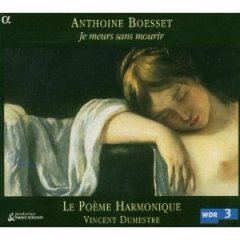Anthoine Boesset – Je Meurs Sans Mourir (2004)
Anthoine Boesset – Je Meurs Sans Mourir (2004)

1.Una musica 2.Départ que le devoir me fait précipiter 3.Ballet des fous & des estropiés de la cervelle (Instrumental) 4.(Entrée de líEmbabouinée - Entrée des demy-fous - Entrée des Fantasques) 5.Ballet des vaillans combattans (Instrumental) play 6.Récit des Syrènes : Quel soleil 7.Récit díAmphion et des Syrènes : Quels doux supplices 8.Récit du Dieu des Songes : Quelle merveilleuse advanture 9.Récit de Mnémosyne : Quelles beautés, Ô mortels 10.Récit du temps : Bien que je vole toutes choses & Aux voleurs, au secours, accourez tous 11.Je meurs sans mourir 12.A la fin cette bergère 13.Entrée des Laquais (Instrumental) 14.Dove ne vai, crudele 15.Frescos ayres del prado 16.La gran chacona (Luis de Briceño) play 17.La Pacifique (Louis Constantin) (Instrumental) Ô Dieu ! 18.Nos esprits libres et contents (Anonyme) Le Poème Harmonique Vincent Dumestre - director Claire Lefilliâtre (dessus), Bruno Le Levreur (haute-contre), Jean-François Novelli (taille), Arnaud Marzorati (basse-contre) Kaori Uemura, Sylvie Moquet (dessus de viole) Sylvia Abramowicz, Anne-Marie Lasla (basse de viole) Françoise Enock (violone) Joël Grare (percussions) Massimo Moscardo (archiluth, guitare baroque) Benjamin Perrot (luth, théorbe) Vincent Dumestre (guitare baroque, théorbe)
This disc is part of a superb series from France's Alpha label, mostly covering early Baroque repertory, that offers handsome packaging bearing an artwork contemporary with the music on the disc, shown both complete and in detail. The painting of Bacchus and Ariadne shown here is attributed to Louis Le Nain, one of those artists you may have sprinted past in the Louvre on your way to see the Mona Lisa. After reading the informative essay here, however, you'll take more time in that gallery on your next visit. The music on the disc, as with many recordings in this series, is even less well known; the composer of most of it, Antoine Boësset (1587-1643), is not even mentioned in music history texts. He was a composer of airs de cour, court airs, for Louis XIII, and that entire genre will be new to most non-French listeners.
On the evidence here, it's a treasure trove. Boësset's pieces are songs for a solo voice or a small group, accompanied by viols and lutes. They are lightly polyphonic at most, and they show the influence of Italian opera -- but it is only an accent, not the meat of the music. A few pieces are in Italian and a few in Spanish, another fashion of the day. The texts are mostly little pastoral scenes or odes to feminine beauty, aimed at exquisite exploration of a specific affect rather than at dramatic impact. There are also texted interludes from the ballet de cour and works from Boësset's contemporaries that fill out the picture of his place and time. One sacred song, Ô Dieu, is included and placed near the end, seemingly as a check on all the frivolity; it is especially lovely, as is the title track of the album, Je meurs sans mourir (I die without dying). There are also some instrumental interludes from dramatic works. The music is graceful, natural, and sensuous in the extreme.
download: uploaded anonfiles mega 4shared mixturecloud yandex mediafire ziddu
Last Updated (Wednesday, 11 September 2013 12:30)








